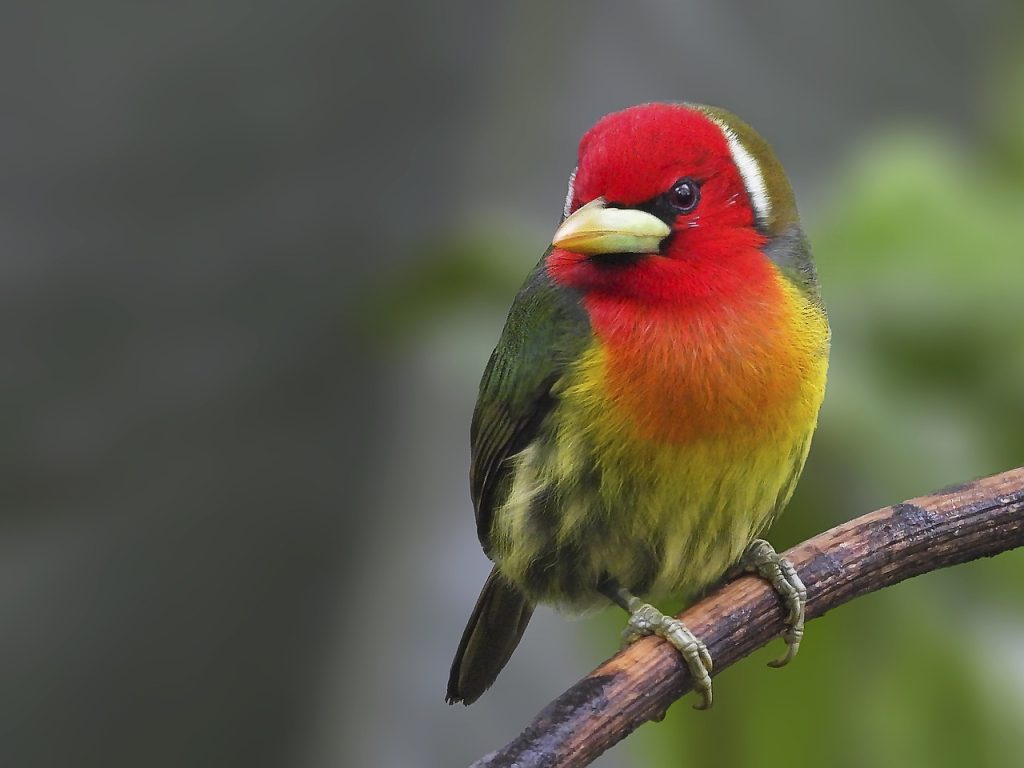
Birds with red heads are relatively uncommon in the UK, but there are a few species that stand out. In this article, we’ll explore nine fascinating birds with red heads or partially red heads: the Black Grouse, Swallow, Pheasant, Goldfinch, European Green Woodpecker, Great Spotted Woodpecker, Lesser Spotted Woodpecker, Lesser Redpoll, and Common Redpoll. Each of these birds has unique characteristics and faces various conservation challenges.
1. Black Grouse
Scientific Name: Tetrao tetrix
Lifespan: 5-12 years
Size: 40-55 cm
Weight: 930-1200 g
Wingspan: 65-80 cm
Population: 4,800 breeding pairs
Status: Red
Only male Black Grouse have partially red heads, characterized by bright red wattles above their eyes. They possess glossy black plumage with a blue or green iridescence and a lyre-shaped tail, which they fan during mating displays. Females are mottled brown and grey for camouflage.
Conservation Note: Black Grouse populations have declined due to habitat loss caused by human activities.
2. Swallow
Scientific Name: Hirundo rustica
Lifespan: 2-3 years
Size: 17-19 cm
Weight: 16-25 g
Wingspan: 32-35 cm
Population: 860,000 breeding territories
Status: Green
Swallows are summer visitors to the UK, arriving in spring and departing in autumn. They are fast fliers with a streamlined body, glossy blue-black back, white underparts, and a distinctive forked tail. The red forehead and throat are often hard to spot due to their swift movements.
Conservation Note: Swallows thrive due to their adaptability in nesting near human habitation.
3. Pheasant
Scientific Name: Phasianus colchicus
Lifespan: Up to 12 years, typically shorter due to hunting
Size: 53-89 cm
Weight: 1.4-2.1 kg
Wingspan: 70-90 cm
Population: 2.3 million breeding females
Status: Not assessed
Male Pheasants are vibrant with iridescent chestnut and golden-brown plumage, black markings, dark green heads, and red facial wattles. Females are more camouflaged with mottled brown plumage.
Conservation Note: Pheasants are bred for hunting and have established wild populations from escaped individuals.
4. Goldfinch
Scientific Name: Carduelis carduelis
Lifespan: 2 years
Size: 12-13 cm
Weight: 14-18 g
Wingspan: 21-25 cm
Population: 1.2 million pairs
Status: Green
Goldfinches are common in the UK, with males displaying a bright red face, black cap, and black around the eyes. Both sexes have a short beak, light brown-grey breast, and black wings with yellow patches.
Conservation Note: Goldfinch numbers are increasing, partly due to their use of bird feeders.
5. European Green Woodpecker
Scientific Name: Picus viridis
Lifespan: 4-6 years
Size: 30-36 cm
Weight: 100-170 g
Wingspan: 38-44 cm
Population: 52,000 breeding pairs
Status: Green
The European Green Woodpecker has bright green upperparts, pale yellowish-green underparts, a yellow rump, and a red crown and nape. Males have a black mustache with a red center.
Conservation Note: While not currently endangered, habitat loss poses a future threat.
6. Great Spotted Woodpecker
Scientific Name: Dendrocopos major
Lifespan: 5-6 years
Size: 23 cm
Weight: 70-90 g
Wingspan: 34-39 cm
Population: 140,000 breeding pairs
Status: Green
Males of this species have black and white checkered upperparts, white underparts, and a crimson patch on the back of their heads. Both sexes have red undertail coverts.
Conservation Note: No serious conservation concerns exist for this species.
7. Lesser Spotted Woodpecker
Scientific Name: Dryobates minor
Lifespan: 2-3 years
Size: 15 cm
Weight: 20-30 g
Wingspan: 25-30 cm
Population: 800-1,000 breeding pairs
Status: Red
This shy species is smaller than the Great Spotted Woodpecker. Males have black and white barring, white underparts with black spots, and a red crown patch. Females have a black cap instead.
Conservation Note: The population has declined by 83% since 1970 due to habitat loss and competition.
8. Lesser Redpoll
Scientific Name: Acanthis cabaret
Lifespan: 2-3 years
Size: 11-12 cm
Weight: 9-12 g
Wingspan: 21-25 cm
Population: 30,000 breeding pairs
Status: Red
Lesser Redpolls are small finches with streaky brown bodies, red patches on the head, and sometimes the breast. Males have more extensive and brighter red patches than females.
Conservation Note: Habitat loss has led to significant population declines, making them a Red List species.
9. Common Redpoll
Scientific Name: Acanthis flammea
Lifespan: 2-4 years
Size: 12-14 cm
Weight: 12-20 g
Wingspan: 19-22 cm
Population: 1-4 breeding pairs
Status: Amber
Common Redpolls, slightly larger than Lesser Redpolls, are winter visitors in the UK. They have a noticeable red cap, some red on the breast, streaky brown plumage, and black streaks with two white wing bars.
Conservation Note: Though not common breeders in the UK, they are frequently seen in winter.
Conclusion
The UK is home to several striking bird species with red heads, including the Black Grouse, Swallow, Pheasant, Goldfinch, European Green Woodpecker, Great Spotted Woodpecker, Lesser Spotted Woodpecker, Lesser Redpoll, and Common Redpoll. While some of these birds are thriving, others face significant conservation challenges. Awareness and conservation efforts are crucial to ensure these birds continue to grace the UK’s landscapes.
